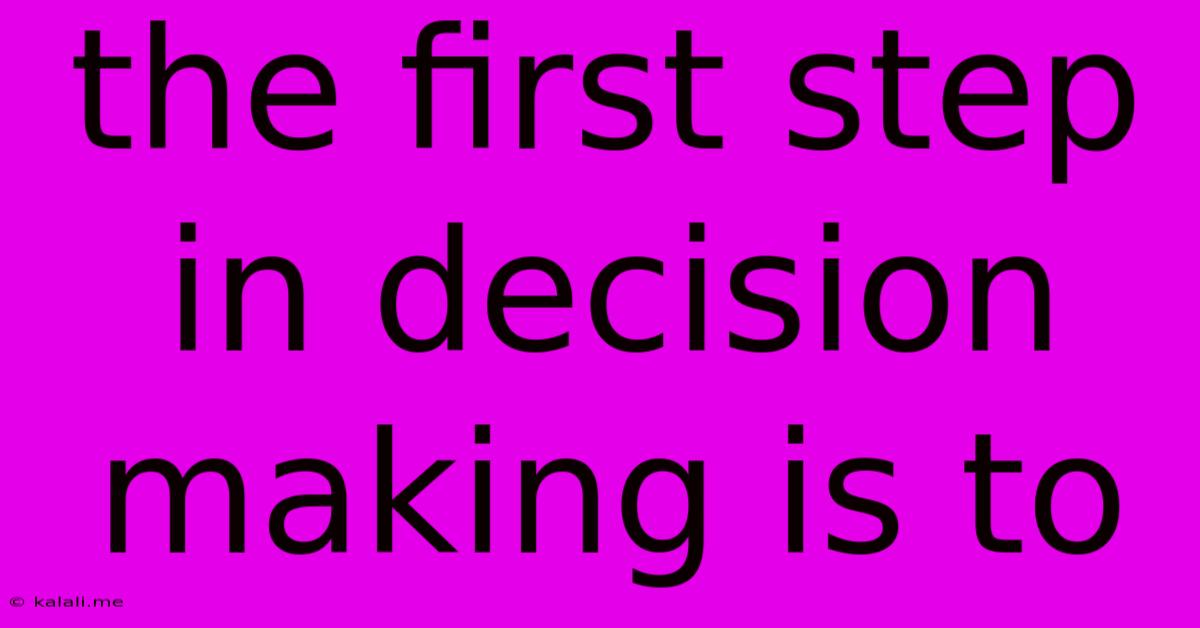The First Step In Decision Making Is To
Kalali
Jun 13, 2025 · 3 min read

Table of Contents
The First Step in Decision Making Is to Define the Problem
Making sound decisions is a crucial skill in all aspects of life, from personal relationships to professional careers. While the process might seem daunting, understanding the foundational steps can significantly improve your decision-making abilities. The very first, and arguably most important, step in effective decision-making is to clearly define the problem. Without a precise understanding of what needs to be decided, all subsequent steps become inherently flawed. This article will explore why defining the problem is paramount and offer practical strategies for achieving clarity.
Why Defining the Problem Is Crucial
Jumping straight into solutions without properly defining the problem is like trying to fix a broken car without knowing what's wrong. You might waste time and resources on ineffective fixes, potentially making the situation worse. A clearly defined problem provides:
- A Foundation for Effective Solutions: A well-defined problem acts as a roadmap, guiding your search for solutions. It clarifies what needs to be achieved, allowing you to evaluate solutions based on their effectiveness in addressing the core issue.
- Focused Analysis: A clear problem statement allows for focused data collection and analysis. You can identify relevant information and avoid getting sidetracked by irrelevant details.
- Reduced Bias: A specific problem statement reduces the influence of personal biases and emotions. By objectively defining the issue, you can approach the decision-making process with greater rationality.
- Improved Communication: A clearly articulated problem facilitates better communication with others involved in the decision-making process. This ensures everyone is on the same page and working towards a common goal.
- Increased Confidence in the Outcome: A thorough understanding of the problem leads to greater confidence in the chosen solution and its implementation.
Strategies for Defining the Problem:
Defining the problem effectively isn't always straightforward. It requires careful consideration and a structured approach. Here are some practical strategies:
- Ask the "5 Whys": This technique involves repeatedly asking "why" to uncover the root cause of the problem. This helps to move beyond surface-level symptoms and identify the underlying issue.
- Describe the Situation Objectively: Focus on facts and avoid emotional language. Use data and evidence to support your description of the problem.
- Identify Stakeholders: Determine who is impacted by the problem and gather their perspectives. This ensures a holistic understanding of the issue.
- Break Down Complex Problems: If the problem is complex, break it down into smaller, more manageable parts. This simplifies the analysis and allows for a more focused approach.
- Quantify the Problem: Whenever possible, quantify the problem using metrics and data. This provides a clear measure of the problem's impact and helps in evaluating the effectiveness of potential solutions.
Moving Beyond Problem Definition:
Once you have clearly defined the problem, you can move on to the subsequent stages of the decision-making process, which include:
- Generating Potential Solutions: Brainstorm various solutions to address the defined problem.
- Evaluating Solutions: Assess the feasibility, effectiveness, and potential consequences of each solution.
- Selecting the Best Solution: Choose the solution that best addresses the problem while considering the various factors involved.
- Implementing the Solution: Put the chosen solution into action.
- Monitoring and Evaluating the Results: Track the outcome of the implemented solution and make adjustments as needed.
By mastering the art of clearly defining the problem, you lay a solid foundation for effective decision-making, leading to more successful outcomes in all areas of your life. Remember, taking the time to properly define the problem is not a delay, but rather a crucial investment in the quality of your decisions.
Latest Posts
Latest Posts
-
Example Of Open Loop Control System
Jun 14, 2025
-
Which Of The Following Is A Weak Electrolyte
Jun 14, 2025
-
Which Of The Following Statements Are True Regarding Electric Generators
Jun 14, 2025
-
Which Era Is Referred To As The Age Of Mammals
Jun 14, 2025
-
All Of The Following Are Classified As Long Bones Except
Jun 14, 2025
Related Post
Thank you for visiting our website which covers about The First Step In Decision Making Is To . We hope the information provided has been useful to you. Feel free to contact us if you have any questions or need further assistance. See you next time and don't miss to bookmark.